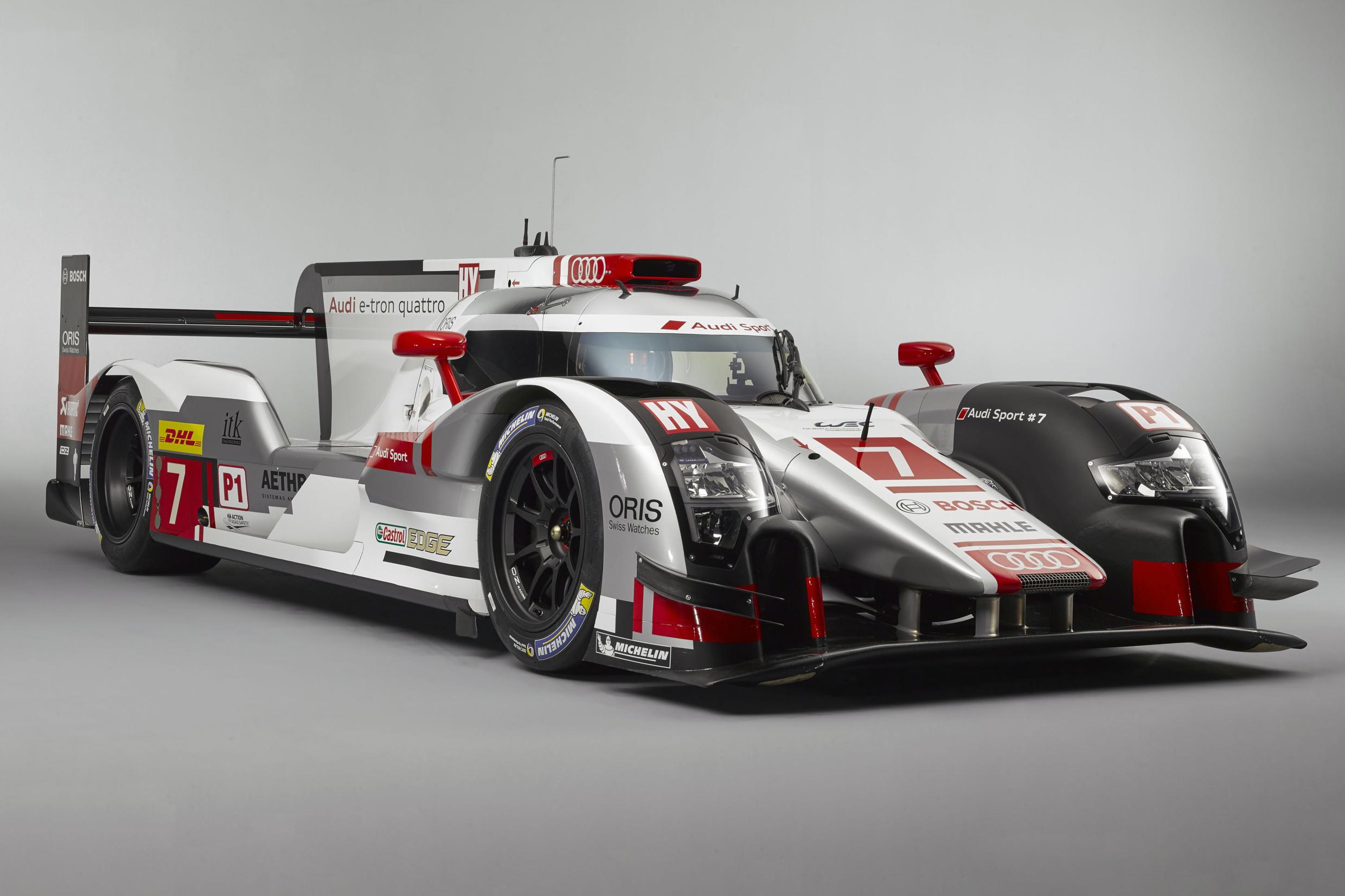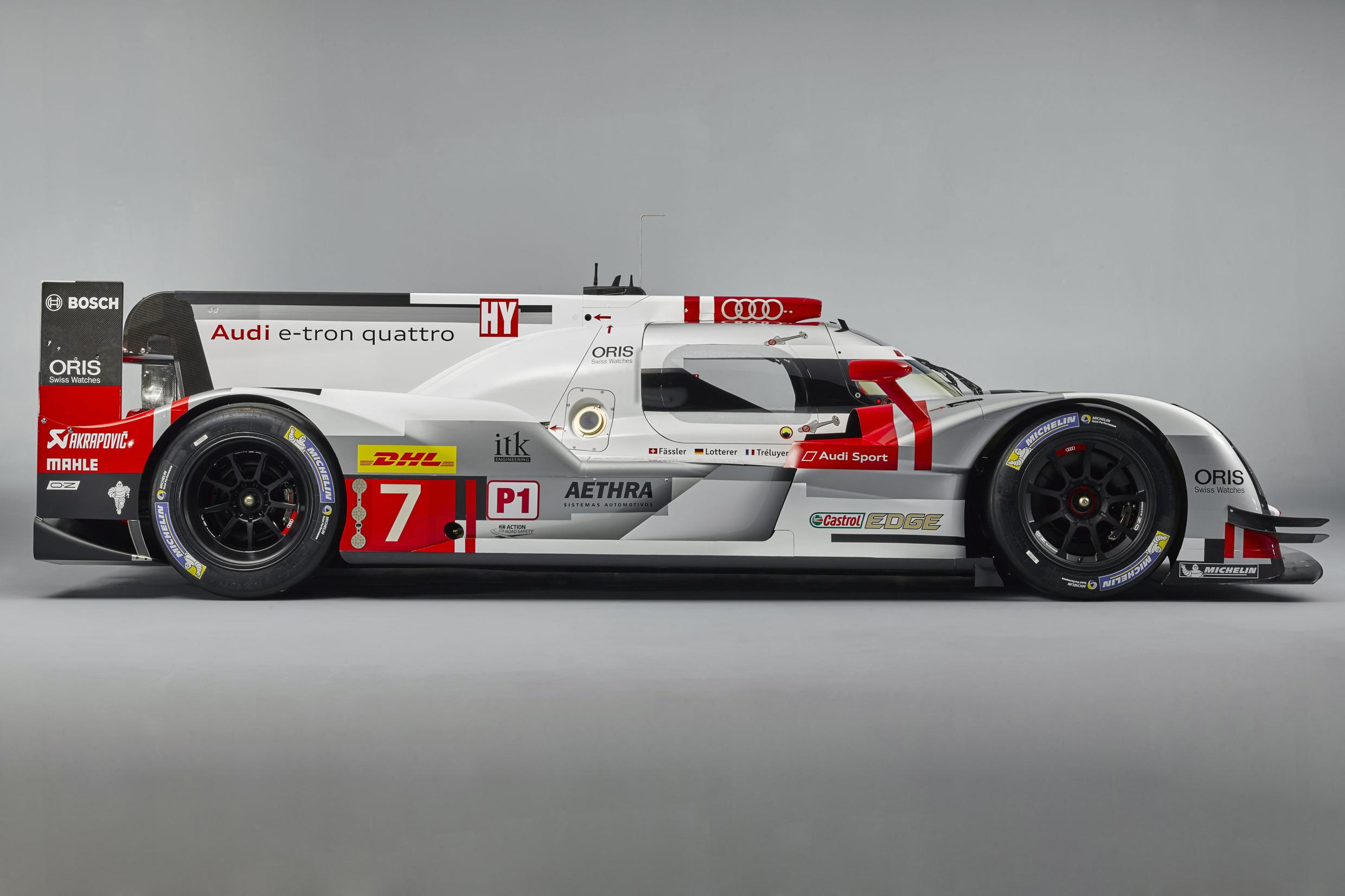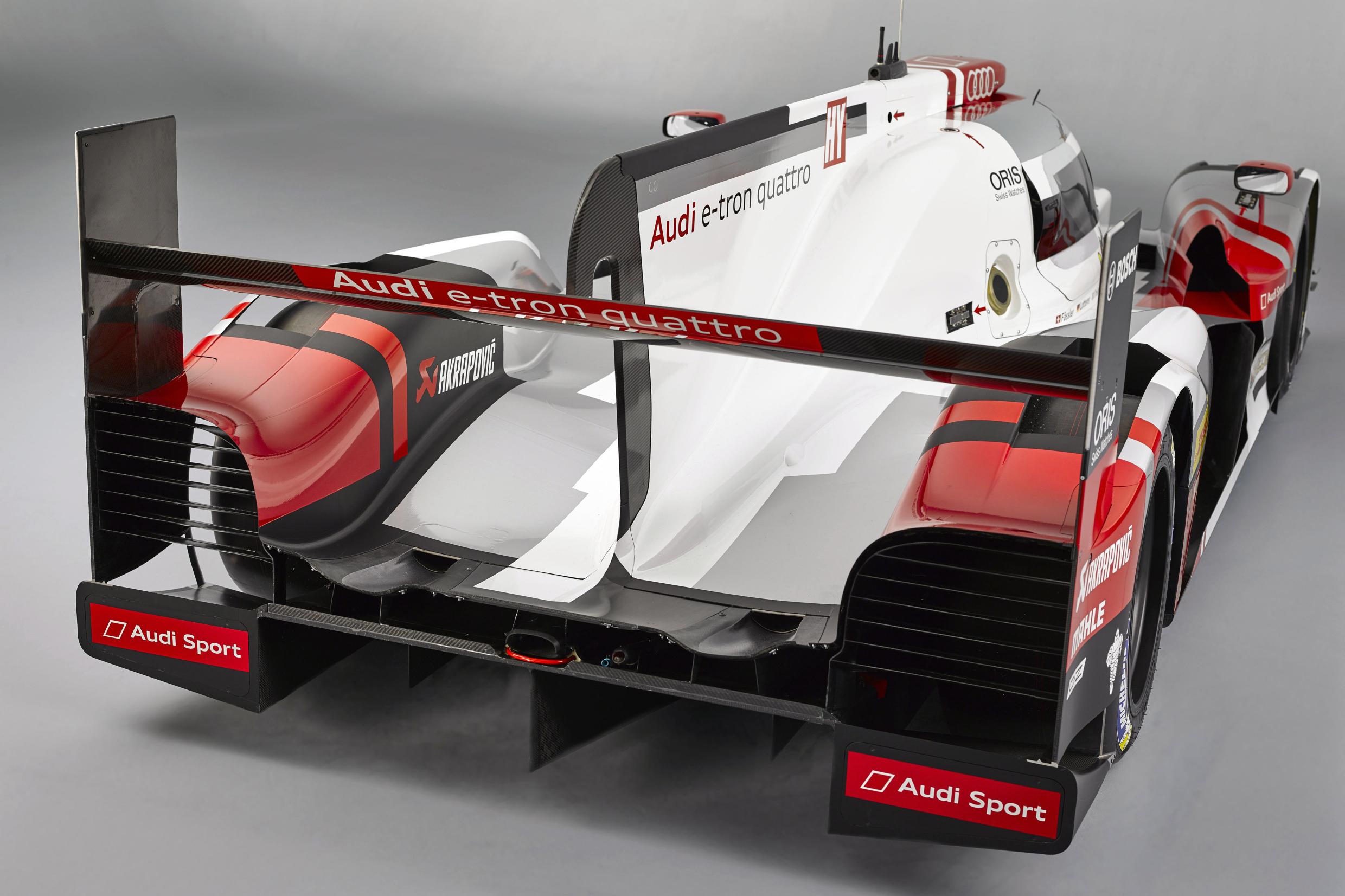
- Aerodynamics, hybrid drive and many other details improved
- Efficient TDI engine consumes even less fuel than before
- Technologies from Le Mans winning cars now in production at Audi
Audi is starting the 2015 season with a thoroughly revised R18 e-tron quattro. In the FIA World Endurance Championship (WEC) and in the Le Mans 24 Hours as the season’s pinnacle event, Audi is going to compete with a hybrid sports car in the 4-megajoule class.
A twofold quantity of hybrid energy, fundamentally revised aerodynamics, the next step in lightweight design and a lot of detailed work characterise the fifth generation of the Audi R18. “The possibilities of the revolutionary regulations that have been in effect for LMP sports cars since 2014 are far from having been fully used. The rules harbour so much potential that there is room for future developments,” says Jörg Zander, Audi Sport’s new Head of Engineering. “We expect that the technological progress resulting from the fierce competitive pressure exerted by four automobile manufacturers that are now involved will significantly improve lap times this season – while concurrently reducing fuel consumption.”
The new R18 e-tron quattro visually differs clearly from its predecessor even though its basic structure is closely akin to the previous model. The fresh look results from a new way of conducting airflow around and through the front end, in the area of the sidepods and at the rear of the LMP1 prototype. Large air inlets in the front wheel arches reduce aerodynamic drag of the body and have led to an all-new design of the headlights. The lighting units feature Matrix LED technology combined with Audi Laserlight – two innovations that improve active safety in road traffic and that Audi customers can now order for their production models as well.
While Audi has adopted the monocoque – the central safety cell of the race car – from the previous model, the hood with the front wing and wheel arches features a new design. As this body element incorporates the crash structure, Audi performed a new crash test for the 2015 season. Modified airflow through the sidepods with new radiator configurations for cooling the engine and the hybrid system further optimises aerodynamic drag. The engine cover, which encloses the unit even more tightly and notably tapers off behind the cockpit, contributes to this as well.
This year, Audi is again preparing two body versions for the various tracks on the FIA WEC calendar. In combination with an optimised chassis and in close cooperation with tire partner Michelin, Audi has further improved the performance potential of its sports prototype this way.

Hybrid pioneer Audi is taking the next step in the area of energy recovery as well. The company is the only manufacturer to date to have won the Le Mans 24 Hours with hybrid sports cars. Since 2012, the R18 e-tron quattro has been unbeaten in the French endurance classic. For this year, the engineers have doubled the amount of energy from 2 to 4 megajoules per race lap at Le Mans. During braking, energy is recovered which the system subsequently feeds back to the front axle on acceleration. The electrical machine that performs this task now delivers an output of more than 200 kW (272 hp), which is a significant increase compared to last year. Therefore, Audi has increased the capacity of the energy storage system as well. The encapsulated flywheel energy storage system that sits in the cockpit alongside the driver can store up to 700 kilojoules of energy that it subsequently returns to the electrical machine – which is about 17 percent more than in 2014.
Despite these performance increases Audi has achieved the minimum weight of only 870 kilograms – notably in what is currently the world’s most complex racing category. The improved hybrid output, however, results in a restriction for the internal combustion engine. According to the sporting regulations the fuel-energy amount has to be further reduced if the engineers opt for higher hybrid output. As a result, the R18 e-tron quattro has to make do with 2.5 percent less diesel fuel per lap than in 2014.
Not least for this reason, Audi has further developed the four-litre V6 TDI engine by performing a lot of detailed work to achieve the optimised consumption levels. The most efficient power-plant in the field now delivers 410 kW (558 hp). Due to its optimised consumption the developers have managed to more than compensate for the loss in output resulting from the reduced amount of fuel. As another new rule this year, only five engines per race car may be used during the entire season. The power-plant now delivering even greater fuel efficiency continues a major trend. In 2006, Audi’s TDI engine debuted at Le Mans, followed by eight victories until 2014. While lap times continually improved, fuel consumption decreased by 38 percent during this period.
As a result, the youngest generation of the R18 emphasises the purpose which motorsport serves at Audi in many fields. Ever since the first Audi quattro was fielded in 1980, the brand has consistently been using circuit racing and rallying for the development of forward-thinking technologies that are subsequently used in production – from quattro four-wheel drive to TFSI gasoline direct injection, to the further development of TDI engines, through to innovations such as Matrix LED light and Audi Laserlight. At the Geneva Motor Show in March, Audi unveiled two other innovations with a reference to motorsport. For the first time, the brand showcased a hybrid model – the Q7 – that combines the e-tron quattro principle with a TDI engine. And the new R8* is the first model featuring the Audi Space Frame as a multi-material construction. In addition to aluminum, the frame includes a component made of carbon fibre reinforced plastics (CFRP), a material that has long become a staple in racing.
*Audi R8:
Combined fuel consumption in l/100 km: 12.4 – 11.8**;
combined CO2 emissions in g/km: 289 – 275**
** The fuel consumption and the CO2 emissions of a vehicle vary due to the choice of wheels and tires. They not only depend on the utilisation of the fuel by the vehicle, but are also influenced by driving behaviour and other non-technical factors.

- Telemetry connection between race car and pit lane
- Permanent acquisition of far more than 1,000 parameters
- Various electronic control units interlinked by a multitude of CAN Bus systems
Ingolstadt, May 5, 2014 – The Audi R18 e-tron quattro is the most complex race car created in Ingolstadt and Neckarsulm to date. This not only applies to the mechanics. The electronics of the most recent LMP1 race car with the four rings is more sophisticated than ever before.
The age of electronic data transmission from the race car on track began for Audi in 1989. At that time, an Audi 90 quattro in the IMSA GTO series radioed eight parameters to the garage where engine speeds and a few pressures and temperatures were plotted on printouts – a tiny step from today’s perspective, but one that provided important insights at the time.
Today, an Audi R18 e-tron quattro on more than a thousand channels, in cycles that in some cases only amount to milliseconds, generates data of crucial importance to a staff of engineers at Audi Sport. At Le Mans, the engineers constantly monitor their race cars for 24 hours. Whether it concerns the functionality of the systems, compliance with the regulations or information that is important for strategic reasons, the race car – similar to a medical EKG system – continually diagnoses its condition and reports it to the team garage.
For this purpose, the LMP1 sports car is equipped with an array of CAN Bus systems which interlink a wide range of electronic control units (ECUs). Sophisticated sensors measure various parameters, such as suspension and acceleration data, temperatures and pressures, or information in the area of energy management, to generate a database for the ECUs. The R18 e-tron quattro has a master system control unit that is primarily responsible for engine and hybrid control and additionally communicates with the other control units in the race car – such as the ECUs for the transmission, clutch actuators, windshield wipers and the laser beam headlights.
The race car has a direct online connection to the computers in the team garage. It is used for high-speed data transmission in real time for operating conditions, such as temperatures, that do not require a high transfer rate. This makes it possible to effectively transfer limited data volumes for a general assessment of the car’s condition. In contrast, the sports car gathers detailed data on each race lap and transmits it via a burst signal when the car drives past the pit lane. Data volumes of more than 20 megabytes are generated per lap, depending on the measurement configuration – equating to more than 10,000 A4 size pages.
Bi-directional data transmission is prohibited. Data may be transmitted from the car to the pits, but not vice versa. Radio communications with the race driver in the car are the only possibility which the team has to influence the car. If there is a need for action based on the engineers’ data analysis this information – such as brake balance, engine control or hybrid system settings – is communicated to the driver by radio. If necessary, alternative program versions stored in the car may be used.
In addition, there is a telemetry system for the officials of the FIA (Fédération Internationale de l’Automobile), which together with the ACO (Automobile Club de l’Ouest) monitors compliance with the regulations: Is the hybrid system within the prescribed amounts of energy? Is the energy consumption of the race car within the prescribed range? Are the boost pressure parameters correct? Does the cockpit temperature remain within the permissible limits?
In addition, the FIA uses a GPS system. This year, the FIA has begun to use this system for measuring whether or not a race driver complies with the speed limit in critical situations, such as caution periods at the scene of an accident. Activities of the marshals (in marshalling areas to secure accident scenes, for example) are also displayed in the cockpit. This provides the driver with assistance that enhances the safety of all the participants. Furthermore, the position of the race car can be tracked on a map of the circuit in real time. Consequently, a modern LMP1 race car is constantly and comprehensively connected with the team and with race control.
